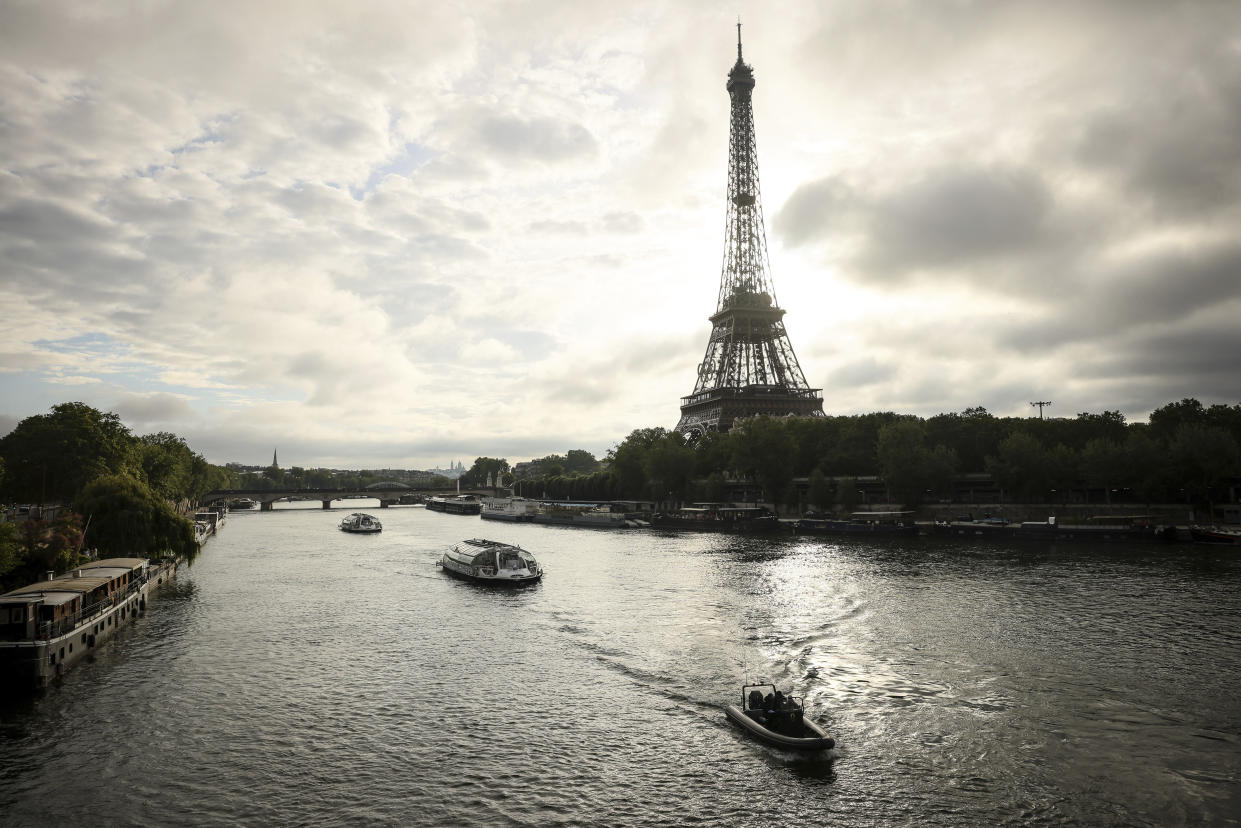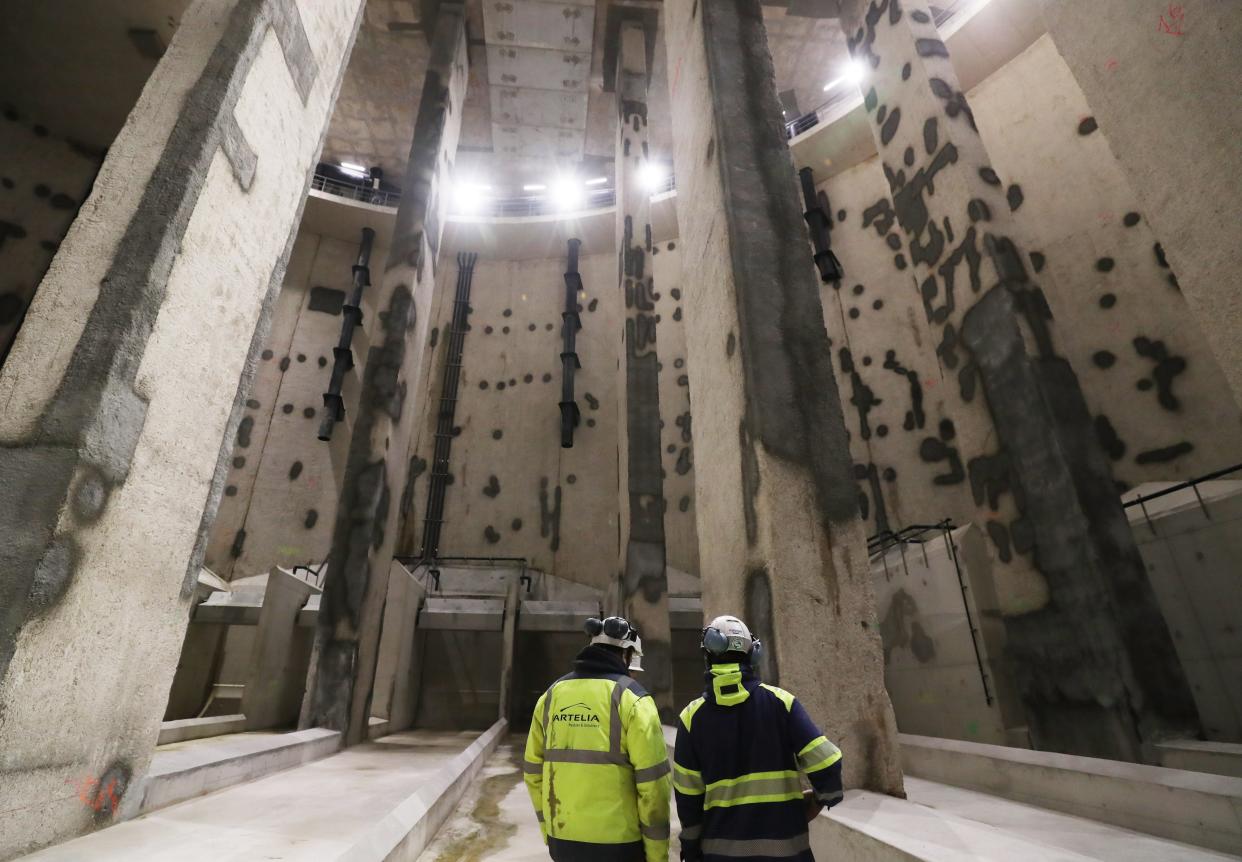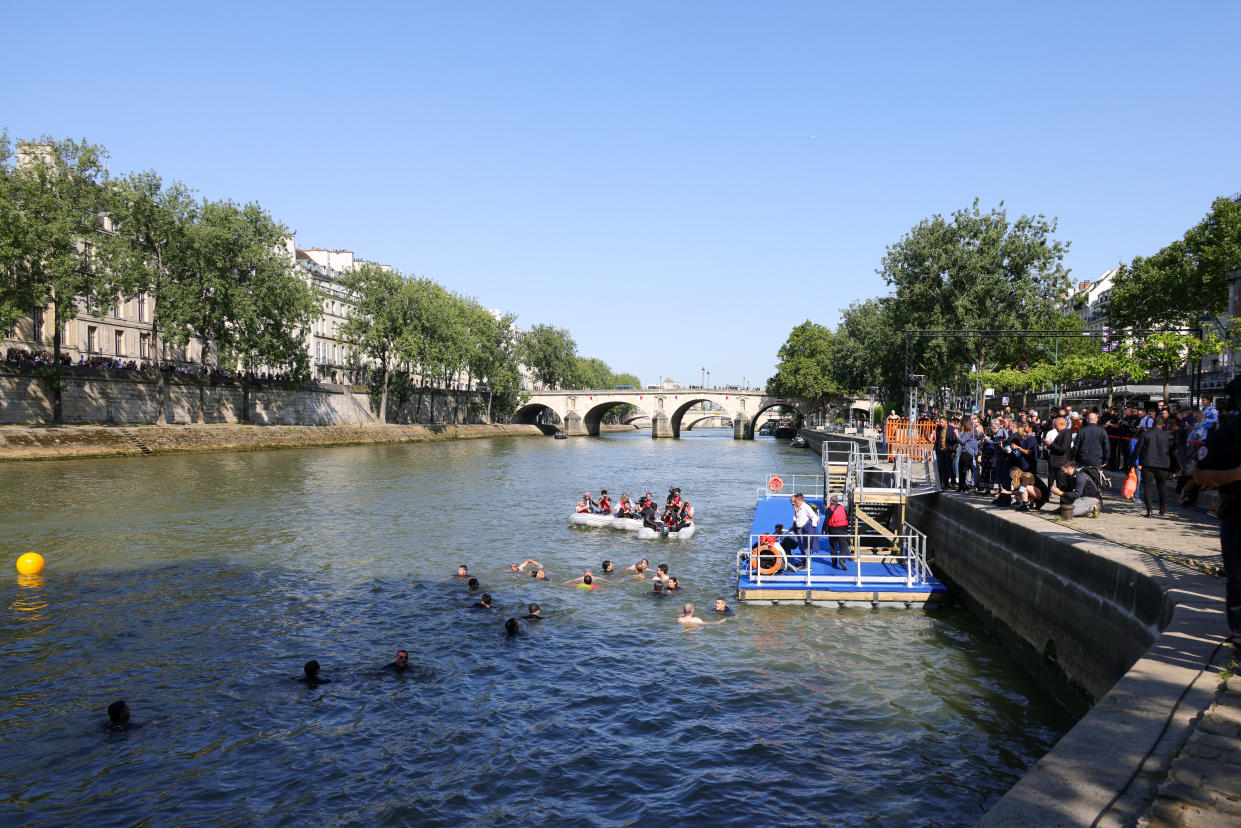From scummy to (maybe) swimmable, the Seine River cleanup is a symbol of the Paris Olympics’ ambitions … and its challenges

PARIS — The world’s most romantic river traces a long arc through Paris, a stunning backdrop to complement the magnificent City of Lights. For centuries, lovers have walked along the Seine River, crossed its bridges, stared into its eddies and ripples. They’ve hung locks on its bridges as a sign of their love, they’ve watched the reflections of golden streetlights waver in the Seine’s current. And while they do, they most definitely stay on shore.
For all of the Seine’s well-deserved accolades as a beautiful, evocative river, only the truly foolish would actually venture into its waters. Because until very recently, the Seine was so toxic that the city didn’t even permit swimming. Too filthy to support much marine life, it’s largely been, in effect, a picturesque garbage dump.
Now, with the Olympics just days away, Paris officials are reaching the end of a years-long plan to clean the river, which will host the Opening Ceremony and, later, several Olympic swimming events. Early Wednesday morning, in an effort to show how clean the river is, Paris mayor Anne Hidalgo and others took a dip in the river's still-murky waters.
“The Seine is exquisite,” Hidalgo said, per the AP. “The water is very, very good. A little cool, but not so bad.’'
Like most Olympic plans, the cleanup of the Seine is a brash, audacious, expensive endeavor … and like so many Olympic plans, it might well collapse under the weight of its own vast ambitions.

The challenge of a billion-dollar cleanup
The Seine cleanup is part of France’s larger goal: to use the Olympics not as a one-stop, over-and-done showcase of glory, but as a springboard to future, sustainable development. The Seine, for instance, will be — in theory — cleaner and more hospitable, suitable for swimming in Paris’ increasingly hot summers. Paris mayor Anne Hidalgo intends to create three public bathing areas in the Seine next summer, and other city officials have echoed her aims.
“We want to make the reconnection of inhabitants with the river, reconnect the people with the water,” Paris deputy mayor Pierre Rabadan told Yahoo Sports. “With increasing degrees and temperatures, we need to re-create a refreshing point in the River Seine. [The Olympics are] playing a massive role in that target.”
Much of the Seine’s problem arises from a longstanding out-of-sight, out-of-mind philosophy. Homes and houseboats upstream of Paris have spent decades simply dumping their untreated sewage and wastewater straight into the river. Within Paris, houseboats have done likewise. The result: a gorgeous toilet.
More than a century ago, the Seine hosted swimming events at the 1900 Olympics, and permitted swimming right up until toxicity concerns — and boat traffic — grew too dangerous for river bathers. So with the Olympics coming to town once again, Paris decided in the mid-2010s to invest $1.5 billion in river improvements, like a water treatment plant in Champigny-sur-Marne and a 46,000-cubic-meter storage basin near the Austerlitz train station designed to collect untreated rainwater. Every day, massive barges and cranes plumb the muck, breaking down and cleaning up one scoop at a time. At the same time, Paris has required all houseboats to hook into the municipal sewer system, cutting off one immediate source of pollution.
“It took a lot of effort to go cut the sources of the pollution at the root, but it’s a very serious piece of work,” Paris 2024 director of sustainability Georgina Grenon told Yahoo Sports in March. “I think everyone’s going to be thrilled about that.”
The backlash arrives … along with the sewage
All of the effort and expense, all of the construction equipment and all of the media attention boils down to one simple question: Is it working? And the answer is … it depends on whom you ask.
“What you have to keep in mind, since [there have been] eight years improving the quality of water, our official laboratory has seen great improvement,” Rabadan said. “The main example is that 30 years ago, there were just three or four different kinds of fish. Now there are more than 22 different kinds of fish. The natural quality of water is much better.”
However, one environmental group contended in April that a “shadow looms over the quality of the water in the Seine River.” Surfrider Foundation Europe conducted 14 samples from September 2023 to April 2024 at both the Alexandre III and Alma bridges, and all showed “unsatisfactory water quality.” The foundation pointed at several sources from “rainfall to malfunctions in the sewage system, including poorly connected barges and animal waste.”
More recently, the mayor’s office acknowledged in June that levels of E.Coli bacteria were 10 times above allowable levels, and in tests never came close to meeting the World Triathlon Federation’s requirements for safe water.
"Water quality remains degraded because of unfavorable hydrological conditions, little sunshine, below-average seasonal temperatures and upstream pollution," the mayor’s office said in a statement. A combination of cloudy days and heavy rainstorms has overwhelmed the city’s ability to mitigate contamination, the mayor’s office said.
The ongoing contamination, combined with France’s ongoing political instability, forced Hidalgo to cancel a planned “Big Dive” for local and national officials to take a swim in the river. Grassroots frustration with the overall cleanup likely had an impact on the Big Dive’s demise, too; last month, angry and creative French protesters rallied around the evocative hashtag #JeChieDansLaSeineLe23Juin (“I crap in the Seine on June 23”). The website, which is still live, declares "Because after putting us in s*** it's up to them to bathe in our s***."
The Seine River swimming experience even inspired its own horror film — “Sous la Seine” (“Under Paris”), a French thriller now streaming on Netflix, featuring a giant shark stalking Olympic swimmers. “Under Paris” is not exactly pristine cinema; Netflix itself suggested alternate titles like “Chomps Elysees” and “Shark de Triomphe.” But it demonstrates exactly how much swimming in the Seine has entered the cultural zeitgeist.

How to swim the Seine … in theory
Putting aside for a moment the question of whether swimming will take place in the Seine, it’s worth asking: How will swimming take place? On that score, Olympic organizers are already well-prepared.
Swimmers will start from Paris’ magnificent Pont Alexandre III, the bridge immediately adjacent to the Grand Palais and Hôtel des Invalides. Male triathletes will swim on July 30, women on July 31. Marathon swimmers will swim on Aug. 8 and 9, and para-triathletes will swim during the Paralympics on Sept. 1 and 2.
Olympic triathlons include a 1.5 kilometer (.93 mile) swim, a 40-kilometer (24.8-mile bike ride, and a 10-kilometer (6.2-mile) run. The triathletes will begin their swim at the Pont Alexander III bridge, will swim two laps — upstream and counterclockwise — and will climb 32 stairs up to the top of the bridge to start the bike ride, finishing with the run.
Athlete reaction to the ongoing river cleanup is the definition of mixed. “I’m not concerned at all,” U.S. triathlete Morgan Pierson told Yahoo Sports in April. “Personally, I can’t control that. I can only really control myself and my training. It’s honestly not worth even thinking about.”
Not everyone is quite so confident. Team USA swimmer Katie Grimes admitted to some trepidation when asked if she was concerned about the quality of the water in the Seine. “Yeah, for sure,” Grimes told Yahoo in June. “We were supposed to have an Olympic test event there last summer, and that got canceled.”
Heavy rains last August forced the cancellation of the Open Water Swimming World Cup, a planned event to give swimmers an up-close look at the river’s swirling currents. “The water quality in the Seine has remained below acceptable standards for safeguarding swimmers’ health,” French Swimming Federation (FFN) said in a statement at the time. Part of the Seine cleanup effort is aimed at containing massive influxes of rainwater that cause exactly these kinds of water quality events.
“I’m sure they know what they’re doing. They’ve had quite a long time to figure this out,” Grimes said. “So, hopefully there’s a backup plan just in case.”
For months, Paris organizers insisted that the backup plan is a flexible calendar, allowing for multiple possible dates to run events in the event water quality falls below acceptable standards. But last Friday, organizers conceded to Reuters that, as a last resort, the events could be held at the Vaires-sur-Marne Nautical Stadium, the locale for rowing and canoeing events, or potentially canceled entirely, turning the triathlon into a duathlon.
Tests between June 24 and July 2 showed that city officials’ hopes for cleaner water with better atmospheric conditions could be paying off. Results found that E.Coli and Enterococci bacteria levels fell below the necessary levels on six of nine days of testing.
International Olympic Committee officials have expressed continuing support for Paris in its Seine plan, indicating there were “no reasons to doubt” that the river would be ready, according to IOC executive Christophe Dubi in a June briefing. “We are confident,” he added, “that we will swim in the Seine this summer.”
Officials acknowledge that there’s more than a little understandable hesitation among Parisian residents about the state of the river; they’ve heard all this before. “Because there’s been such a political promise for so many years, so many decades, [Parisians] are still hesitant about it,” Grenon said. “But we are within, we see the results, we see the works. And the moment I’m given a green light, I’ll put on a swimsuit and jump in the water.”


